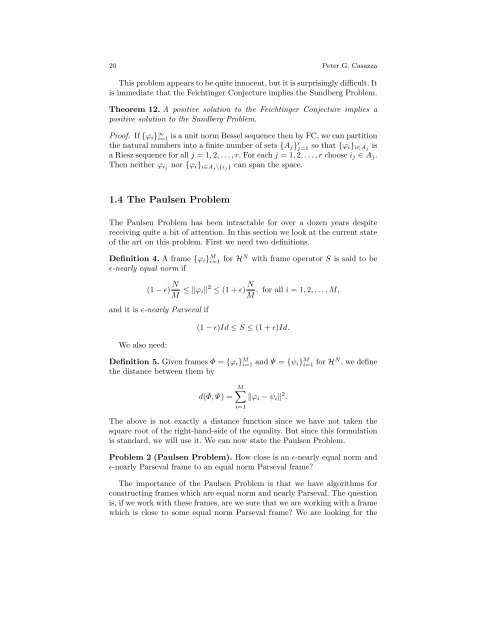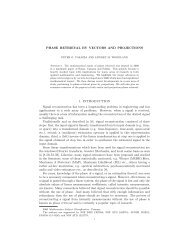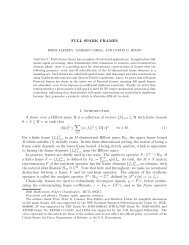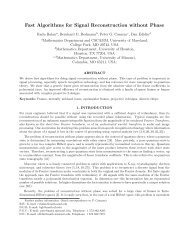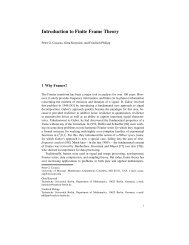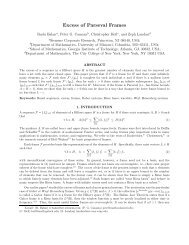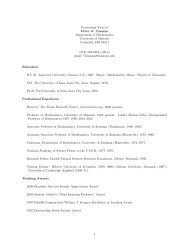The Kadison-Singer and Paulsen Problems in Finite Frame Theory
The Kadison-Singer and Paulsen Problems in Finite Frame Theory
The Kadison-Singer and Paulsen Problems in Finite Frame Theory
Create successful ePaper yourself
Turn your PDF publications into a flip-book with our unique Google optimized e-Paper software.
20 Peter G. CasazzaThis problem appears to be quite <strong>in</strong>nocent, but it is surpris<strong>in</strong>gly difficult. Itis immediate that the Feicht<strong>in</strong>ger Conjecture implies the Sundberg Problem.<strong>The</strong>orem 12. A positive solution to the Feicht<strong>in</strong>ger Conjecture implies apositive solution to the Sundberg Problem.Proof. If {ϕ i } ∞ i=1 is a unit norm Bessel sequence then by FC, we can partitionthe natural numbers <strong>in</strong>to a f<strong>in</strong>ite number of sets {A j } r j=1 so that {ϕ i} i∈Aj isa Riesz sequence for all j = 1, 2, . . . , r. For each j = 1, 2, . . . , r choose i j ∈ A j .<strong>The</strong>n neither ϕ ij nor {ϕ i } i∈Aj\{i j} can span the space.1.4 <strong>The</strong> <strong>Paulsen</strong> Problem<strong>The</strong> <strong>Paulsen</strong> Problem has been <strong>in</strong>tractable for over a dozen years despitereceiv<strong>in</strong>g quite a bit of attention. In this section we look at the current stateof the art on this problem. First we need two def<strong>in</strong>itions.Def<strong>in</strong>ition 4. A frame {ϕ i } M i=1 for HN with frame operator S is said to beɛ-nearly equal norm if(1 − ɛ) N M ≤ ‖ϕ i‖ 2 ≤ (1 + ɛ) N , for all i = 1, 2, . . . , M,M<strong>and</strong> it is ɛ-nearly Parseval ifWe also need:(1 − ɛ)Id ≤ S ≤ (1 + ɛ)Id.Def<strong>in</strong>ition 5. Given frames Φ = {ϕ i } M i=1 <strong>and</strong> Ψ = {ψ i} M i=1 for HN , we def<strong>in</strong>ethe distance between them byd(Φ, Ψ) =M∑‖ϕ i − ψ i ‖ 2 .i=1<strong>The</strong> above is not exactly a distance function s<strong>in</strong>ce we have not taken thesquare root of the right-h<strong>and</strong>-side of the equality. But s<strong>in</strong>ce this formulationis st<strong>and</strong>ard, we will use it. We can now state the <strong>Paulsen</strong> Problem.Problem 2 (<strong>Paulsen</strong> Problem). How close is an ɛ-nearly equal norm <strong>and</strong>ɛ-nearly Parseval frame to an equal norm Parseval frame?<strong>The</strong> importance of the <strong>Paulsen</strong> Problem is that we have algorithms forconstruct<strong>in</strong>g frames which are equal norm <strong>and</strong> nearly Parseval. <strong>The</strong> questionis, if we work with these frames, are we sure that we are work<strong>in</strong>g with a framewhich is close to some equal norm Parseval frame? We are look<strong>in</strong>g for the


